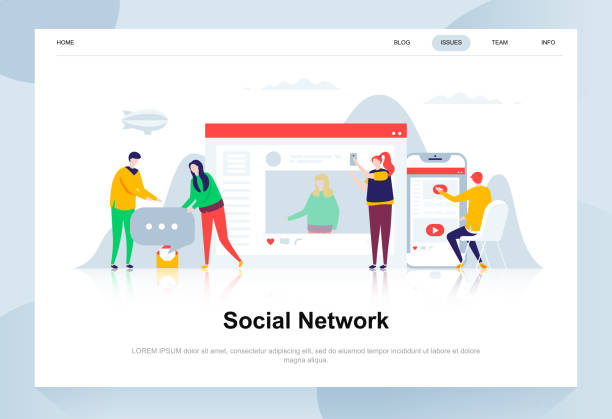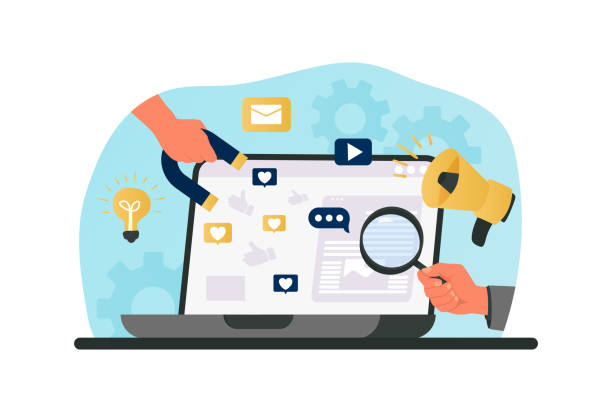Why Secure Website Design is Crucial?

In today’s digital world, website security is not an option, but an undeniable necessity.
#SecureWebsiteDesign has become more important than ever, as cyberattacks are becoming more complex and targeted every day.
These attacks can lead to the loss of sensitive data, damage to brand reputation, and irreversible financial losses.
An insecure website is an open door for hackers and malware to access not only your website’s information but also user data.
Today, understanding the principles of secure website design is essential for every business, from small startups to large corporations. Failure to adhere to these principles can result in heavy legal penalties, especially when users’ personal information is compromised.
In fact, this is an explanatory and educational approach that should always be considered.
For example, in recent years we have witnessed a significant increase in ransomware attacks targeting many small and large websites.
These attacks show that no website is immune to danger and continuous efforts must be made to increase its stability and security.
Secure website design is an ongoing process that keeps pace with evolving security needs and requires continuous updates and awareness of the latest threats.
The ultimate goal of secure website design is to create a trustworthy and protected online environment for users and website owners.
This includes protecting sensitive data such as credit card information, passwords, and customers’ personal details.
A website that adheres to security principles gains user trust and boosts business.
Also, by reducing the risk of cyberattacks, potential costs associated with system recovery and damage compensation are significantly reduced.
In the long run, this proactive approach will bring significant economic and reputational benefits and save you from post-attack confusion.
Does your company’s website create a professional and lasting first impression on potential customers? Rasav, with its professional corporate website design, not only represents your brand’s credibility but also opens a path for your business growth.
✅ Create a powerful and reliable brand image
✅ Attract target customers and increase sales
⚡ Get free consultation
Familiarity with Common Web Vulnerabilities

To achieve #SecureWebsiteDesign and resilience, we must first become familiar with the most common #WebVulnerabilities.
This understanding helps us to approach security issues with a more comprehensive view and adopt appropriate solutions to counter them.
Among the most important of these vulnerabilities are SQL Injection, Cross-Site Scripting (XSS), and Cross-Site Request Forgery (CSRF), which are widely exploited.
SQL Injection is one of the most dangerous attacks, allowing an attacker to inject malicious SQL code into website input fields.
This can lead to unauthorized access to the database, modification or deletion of information, and even full control over the server.
To prevent this type of attack in secure website design, using Prepared Statements and input parameterization is essential.
These methods ensure that user inputs are interpreted as data, not code.
XSS allows an attacker to inject malicious code (usually JavaScript) into web pages, which is then executed by other users’ browsers.
This attack can be used to steal cookies, hijack user sessions, or even alter page content.
Filtering and strict validation of user inputs, as well as Output Encoding, are among the most important prevention methods in secure website design.
These measures prevent injected code from being executed by the browser.
CSRF is another attack where the attacker tricks the user into sending unwanted requests to a website without their knowledge.
These requests can include changing passwords, making financial transactions, or sending spam emails.
Using anti-CSRF tokens, checking the Referrer, and ensuring the use of correct HTTP methods (such as POST for sensitive operations) are among the solutions to counter this vulnerability.
This type of specialized and analytical content is crucial for a deep understanding of the risks.
The OWASP Top 10 project annually publishes a list of the top 10 most critical web vulnerabilities, which is essential reading for every developer and website owner to gain a comprehensive understanding of threats.
Secure Coding Practices and Development Principles

One of the main pillars of #SecureWebsiteDesign is adhering to #SecureCodingPractices throughout all development stages.
This section provides educational and guidance on key points for developers to create robust software resilient to cyberattacks.
These principles include strict input validation, proper error handling, and appropriate encryption for sensitive information, all of which form the foundation of a robust website.
Input validation must be performed on both the client-side and the server-side.
Server-side validation is more critical as attackers can easily bypass client-side validation.
All user inputs must be carefully checked to ensure they conform to expected formats and to prevent any malicious characters or injected code.
Error handling also plays a crucial role in secure website design.
General error messages should be displayed to the user, and providing technical details that could be useful to attackers should be avoided.
Logging errors and security events in the background is very important for future analysis, as it helps identify attack patterns and improve the system.
For storing passwords, they should never be stored in plain text.
Using strong hashing functions like BCrypt or Argon2 along with a proper Salt for each password is a secure method.
Furthermore, sensitive information such as API keys or database connection details should not be hardcoded in the source code; instead, environment variables or secure key management systems should be used.
This table summarizes some of the most important secure coding principles and their applications in secure website design:
| Security Principle | Description | Practical Example |
|---|---|---|
| Input Validation | Careful checking of data received from the user to prevent code injection and attacks. | Using regular expressions (Regex) for email and phone number fields, and filtering HTML tags. |
| Secure Output | Proper encoding of data before displaying it to the user to prevent XSS and other injection attacks. | Using htmlspecialchars() in PHP or sanitizer in JavaScript to display user-generated content. |
| Data Encryption | Protecting sensitive information during transmission (over the network) and storage (in the database). | Using HTTPS for communications, and strong hashing functions (like Bcrypt) for user passwords. |
| Session Management | Protecting user sessions against hijacking and unauthorized access. | Using HttpOnly and Secure cookies, session regeneration after logging in or changing privileges. |
| Error Handling and Logging | Hiding technical details from the user and accurately recording security events for analysis. | Displaying generic error messages to the user and logging technical details in server and system log files. |
Also, using up-to-date and reputable frameworks and libraries that adhere to security principles can significantly reduce the developer’s security burden.
This is specialized content that helps developers to address the security aspects of their projects with greater care and achieve a secure website design and stable.
The Importance of HTTPS and SSL/TLS Certificates

In the discussion of #SecureWebsiteDesign, #HTTPSProtocol and #SSLTLS_Certificates play a pivotal role.
HTTPS (Hypertext Transfer Protocol Secure) is the secure version of HTTP that uses Transport Layer Security (TLS) encryption to secure communication between the user’s browser and the website server.
This content adopts an explanatory and specialized approach to help users and developers understand the importance of these technologies.
When a user enters sensitive information such as passwords, credit card details, or personal data on a website, HTTPS ensures that this information is encrypted during transmission and protected from unauthorized access.
Without HTTPS, data is sent in plain text and can easily be intercepted or altered by attackers on the network.
This severely compromises data privacy and integrity.
SSL/TLS certificates (Secure Sockets Layer/Transport Layer Security) verify the website’s identity and enable encrypted communication.
When a browser opens a website with a valid certificate, it identifies it as a trusted site and displays a green padlock icon in the address bar.
This assures users that they are interacting with a legitimate and secure website and that their information is not at risk.
There are different types of SSL/TLS certificates, including:
- Domain Validation (DV) Certificate: The cheapest and fastest type, which only verifies domain ownership.
Suitable for blogs and personal websites. - Organization Validation (OV) Certificate: Also verifies the organization’s identity and is suitable for business websites.
These certificates offer greater credibility. - Extended Validation (EV) Certificate: Offers the highest level of trust and turns the browser’s address bar green, displaying the organization’s name.
These certificates are ideal for banks and financial websites, attracting maximum trust.
In addition to security, HTTPS also has SEO benefits.
Google considers HTTPS as a ranking signal, meaning websites with HTTPS may achieve a better rank in search results.
Using HTTPS is a requirement for modern secure website design, and without it, your website will not only be considered insecure but its user experience and credibility will also be severely damaged. Migrating to HTTPS should be the first step in any secure website design project to lay strong security foundations from the outset.
Tired of your e-commerce website not generating as much revenue as its potential? Rasav, specializing in professional e-commerce website design, solves this problem for good!
✅ Increase sales rate and revenue
✅ High loading speed and exceptional user experience
⚡ Get free e-commerce website design consultation
Authentication and Access Management in Secure Website Design

One of the critical areas in #SecureWebsiteDesign is #Authentication and #AccessManagement.
These two concepts, respectively, ensure who accesses the system (authentication) and what they can do (access management or authorization).
This section offers a guidance and educational approach to help implement these mechanisms in the best possible way and ensure the security of user accounts.
For authentication, using stronger methods than just username and password is highly recommended.
Two-Factor Authentication (2FA) or Multi-Factor Authentication (MFA) should be enabled for all user accounts, especially administrative accounts.
These methods prevent unauthorized access by adding extra security layers (such as a code sent to a mobile phone, fingerprint, or a physical security key), even if the password is compromised.
Strong passwords are also of paramount importance.
Users should be encouraged to use complex passwords including uppercase and lowercase letters, numbers, and symbols.
Website systems should enforce strong password policies, such as requiring password changes at regular intervals or preventing the reuse of previous passwords.
Password storage should be done using strong hashing algorithms along with appropriate salt, as previously mentioned, to protect against dictionary and brute-force attacks.
In access management, the Principle of Least Privilege must be observed.
This means that each user or process should only be granted the minimum necessary access to perform its tasks.
For example, a regular user should not have access to administrative functions or the database.
Implementing Role-Based Access Control (RBAC) systems, where access is granted based on predefined roles (such as administrator, editor, regular user), helps streamline and enhance access management security.
These principles are essential for secure website design and help prevent both internal and external breaches.
Furthermore, continuous monitoring of user activity and logging unsuccessful login attempts and unauthorized accesses help in rapid attack identification.
This information can be used to analyze attack patterns and improve security policies.
Implementing these mechanisms provides a robust layer of protection for your website.
Choosing Secure Hosting and Server Configuration

A part of the #SecureWebsiteDesign puzzle often overlooked is #SecureHostingSelection and #ProperServerConfiguration.
Even a perfectly secure website code will be at risk if run on a vulnerable infrastructure.
This section provides guidance and specialized insights into the importance of these choices and offers key solutions to ensure your website’s infrastructure is as secure as its code.
Features of Secure Hosting:
Choosing a reputable hosting provider committed to security is the first step.
You should look for hosting providers that have:
- Powerful Network Firewalls: To protect against DDoS attacks and other network threats at the infrastructure layer.
- Intrusion Detection and Prevention Systems (IDS/IPS): The presence of these systems at the network level can provide an additional defensive layer and identify and block suspicious activities.
- Regular Software Updates: The hosting provider must ensure that all server software (such as operating system, web server, database) is up-to-date and patched.
- Regular Backups and Disaster Recovery Solutions: To ensure the ability to return to normal in case of a disaster.
- High Physical Security: Data centers must have strict access control and 24/7 monitoring.
- Expert Security Support Team: To respond quickly to security incidents.
Secure Server Configuration:
After choosing suitable hosting, server configuration is also of high importance.
This includes:
- Remove Unnecessary Software: Any additional service or software installed on the server creates a potential weak point for intrusion and should be removed or disabled.
- Change Default Passwords: All default passwords (such as SSH, FTP, control panel) must be changed to strong and unique passwords.
- Restrict SSH/FTP Access: Use key-based authentication for SSH and disable FTP if not needed.
Also, changing the default SSH port is recommended to reduce automated attacks. - Server Firewall Settings: Configure software firewalls (such as UFW in Linux) to block unnecessary ports and allow access only to authorized traffic.
- Continuous Security Updates: Enable automatic updates for the operating system and server software or ensure they are performed manually on a regular basis.
- Monitor Logs: Regularly review server logs to identify suspicious activities and intrusion attempts.
Cost-cutting in hosting and server configuration can directly impact website security and lead to significantly higher costs in the long run. Therefore, investing in reputable hosting and adhering to secure configuration principles is an indispensable part of secure website design and stability that should not be overlooked.
Data Privacy and Compliance (GDPR, CCPA)

In the digital age, #DataPrivacy and compliance with #PrivacyRegulations are fundamental pillars of #SecureWebsiteDesign and responsible conduct.
This section addresses the importance of this topic with thought-provoking and specialized content.
Did you know that non-compliance with these regulations can lead to very heavy financial penalties and serious damage to your business’s reputation? In today’s world, where data holds high value, protecting it is of particular importance.
Important regulations such as GDPR (General Data Protection Regulation) in Europe and CCPA (California Consumer Privacy Act) in California have set strict standards for the collection, processing, and storage of personal data.
The main goal of these regulations is to empower individuals over their personal data and oblige companies to protect user privacy.
This means greater transparency and more control for users.
The most important principles of these regulations include:
- Explicit Consent: Users must clearly and knowingly agree to the collection of their data.
This consent must be verifiable. - Right to Access: Users have the right to be informed about and access their personal data collected by the website.
- Right to Erasure / Right to be Forgotten: Users have the right to request the deletion of their data, and the website is obliged to fulfill this request.
- Data Security: Companies are obliged to adopt sufficient security measures to protect personal data against unauthorized access, loss, or disclosure.
- Privacy by Design: Privacy must be considered from the initial stages of system design.
To comply with these regulations in secure website design, websites must:
- Have a clear, comprehensive, and understandable privacy policy that is easily accessible to users.
- Provide clear mechanisms for users’ requests to access, correct, or delete data.
- Only collect data that is essential for providing services (Principle of Data Minimization).
- Adopt appropriate technical and organizational security measures to protect data against unauthorized access, loss, or disclosure.
This table summarizes the key differences between two important privacy laws that are vital for secure website design and compliance with legal obligations:
| Feature | GDPR (Europe) | CCPA (California, USA) |
|---|---|---|
| Scope | Any organization that processes the data of EU citizens, regardless of the organization’s location. | Companies that meet at least one of these criteria: annual gross revenue over $25 million; buy, receive, sell, or share personal information of 50,000 consumers; 50% or more of annual revenue from selling personal information of California residents. |
| Key Concepts | Right to be forgotten, explicit consent, Privacy by Design, Data Protection Impact Assessment (DPIA). | Right to know, right to delete, right to opt-out of the sale of personal information, right to non-discrimination. |
| Penalties for Violation | Up to €20 million or 4% of global annual turnover (whichever is higher) for major violations. | $7,500 for each intentional violation, $2,500 for each unintentional violation. Also, the possibility of private right of action for data breaches. |
Compliance with these regulations not only prevents heavy penalties but also significantly contributes to building user trust and loyalty.
A website that prioritizes user privacy will be more successful in the long run and will be recognized as a responsible entity.
Web Application Firewalls (WAF) and Intrusion Detection Systems (IDS)

Continuing the topic of #SecureWebsiteDesign, familiarity with #WebApplicationFirewalls (WAF) and #IntrusionDetectionSystems (IDS) is of particular importance.
These technologies act as powerful defensive lines and are explained in an explanatory and specialized manner to clarify their role in a comprehensive security strategy.
These tools complement each other and create multiple layers of defense.
A Web Application Firewall (WAF) is a security layer that sits between the user and the web server.
WAF monitors, filters, and blocks HTTP/HTTPS traffic.
This firewall can prevent common web attacks such as SQL Injection, XSS, and CSRF, even before they reach the web application server.
WAFs can be implemented as hardware, software, or as a cloud service (SaaS).
The main advantage of WAF is that it can dynamically update its rules based on known attack patterns and unusual behavior.
These tools are essential for secure website design, which is constantly exposed to new threats, and act as a protective guard.
Intrusion Detection Systems (IDS), as their name suggests, identify suspicious or malicious activities on a network or system.
IDS actively monitors network traffic and alerts if it observes patterns matching known attacks.
IDS can operate based on signatures (Signature-based IDS) or behavior (Anomaly-based IDS).
Signature-based IDS look for patterns of known attacks, while anomaly-based IDS detect abnormalities in network traffic or system behavior that could indicate a new attack.
After detecting an intrusion, IDS usually sends alerts to system administrators so that necessary actions can be taken.
The key difference between WAF and IDS is that WAF actively prevents attacks (Preventive), while IDS is primarily designed for detection and alerting (Detective).
In a comprehensive secure website design strategy, both tools play complementary roles.
WAF is on the front line of defense, and IDS helps identify threats that may have bypassed the WAF or are of a different type, assisting with post-attack root cause analysis.
The use of these advanced security tools can significantly increase the website’s protection level and reduce the risk of successful cyberattacks.
Investing in these technologies is an essential part of the commitment to secure website design and the protection of sensitive information.
These solutions help organizations actively and efficiently confront the increasing security challenges.
Does your current website convert visitors into customers, or does it drive them away? With professional corporate website design by Rasav, solve this problem for good!
✅ Build strong credibility and branding
✅ Attract target customers and increase sales
⚡ Get free consultation now!
Incident Response and Disaster Recovery

Despite all preventive measures in #SecureWebsiteDesign, the possibility of a #SecurityIncident or #CyberDisaster is never zero.
Therefore, having a comprehensive plan for #IncidentResponse and #DisasterRecovery is critical.
This section provides guidance and educational content on the importance of preparing for worst-case scenarios so organizations can quickly return to normal with minimal damage during crises.
An Incident Response Plan is a roadmap that guides the security team during a cyberattack or security breach.
This plan includes the following steps, which must be carefully planned and practiced:
- Preparation: Training the security team, defining roles and responsibilities, preparing necessary tools and processes.
This stage includes establishing an incident response team and defining communication protocols. - Identification: Early detection of security incidents through system monitoring, log analysis, and alert response.
The goal is to understand the nature and extent of the attack. - Containment: Isolating compromised systems to prevent the spread of the attack to other parts of the network.
This stage may involve disconnecting the network or disabling specific services. - Eradication: Completely removing the intrusion agent (e.g., malware) and fixing vulnerabilities that led to the attack.
This includes cleaning systems and applying security patches. - Recovery: Restoring systems and data to normal and secure operational status.
This stage involves restoring from valid backups and restarting services. - Lessons Learned: Comprehensive analysis of the incident to identify root causes, improve future security processes, and prevent similar occurrences.
This stage is critical for continuous improvement.
A Disaster Recovery Plan (DRP) focuses on ensuring business continuity in the event of catastrophic incidents such as widespread hardware failure, natural disasters, or crippling cyberattacks.
Key components of DRP include:
- Regular Backups: Regularly backing up data and systems and storing them in secure, separate locations (off-site).
- Rapid Recovery: The ability to restore systems and data in the shortest possible time (RTO – Recovery Time Objective) and with minimal data loss (RPO – Recovery Point Objective).
- Periodic Testing: Testing the recovery plan to ensure its effectiveness and currency.
These tests should be conducted regularly to identify potential weaknesses.
Without a comprehensive incident response and disaster recovery plan, even a secure website design can completely fail in the face of a complex attack or disaster, causing irreparable damage.
Preparing for these scenarios not only reduces risks but also allows the business to return to normal more quickly and maintain customer trust. This section helps you to be prepared for your secure website design in any situation and ensure the continuity of your business.
The Future of Web Security, Continuous Improvement, and User Education

The world of #WebSecurity is constantly changing and evolving.
What is known today as #SecureWebsiteDesign might not be enough tomorrow.
This section provides an analytical and engaging perspective on the future outlook and the importance of continuous improvement in this field, highlighting the critical role of the human factor.
Are you ready to face tomorrow’s unknown threats?
Cyber threats are becoming more complex and intelligent day by day.
The emergence of Artificial Intelligence (AI) and Machine Learning (ML) in cyberattacks means that attackers can rapidly identify vulnerabilities and plan more targeted attacks.
On the other hand, these very technologies can be used as powerful tools for defense and enhancing website security, for example, in detecting intrusion patterns and automated threat response.
Some future trends in web security include:
- AI-based Security: Using AI to detect complex attack patterns and identify unknown threats (Zero-day attacks) with unprecedented speed and accuracy.
- Cloud Security: With increasing migration to the cloud, the security of cloud platforms and applications will gain increasing importance, requiring new security specializations.
- Passwordless Authentication: Replacing passwords with more secure and convenient methods such as biometrics, FIDO2, or security keys that offer greater resistance to phishing attacks.
- API Security: With the increasing use of APIs in web development and inter-service communication, protecting these interfaces against injection attacks, unauthorized access, and DDoS attacks will become crucial.
Continuous improvement is a fundamental principle in secure website design.
Security is not a one-time project, but an ongoing process that includes the following:
- Regular Updates: Keeping operating systems, frameworks, libraries, and plugins up-to-date to address known vulnerabilities.
- Continuous Monitoring: Monitoring website activities to identify anomalies and threats in real-time.
- Ongoing Team Training: Updating the knowledge of the development and security teams about the latest threats, best practices, and new tools.
- Feedback and Iteration: Using lessons learned from incidents and security audits to strengthen security systems and improve processes.
In addition to technical aspects, #UserEducation and #SecurityAwareness are as important as secure coding and server configuration.
Social Engineering is one of the most common and effective attack methods, targeting individuals rather than systems.
Educating users on how to identify phishing attacks, the importance of using strong passwords and two-factor authentication, and caution when clicking suspicious links can create a powerful human defense layer.
A secure website design is not limited to technical issues; it also depends on fostering a security culture.
The future of the web will be more secure but with more complex threats. Websites that currently focus on secure website design and continuous improvement will be better prepared to face future challenges and maintain user trust.
This approach signifies proactive and pragmatic thinking in the field of security.
Frequently Asked Questions
| Question | Answer |
|---|---|
| 1. What does secure website design mean? | Secure website design means creating a website that is resistant to cyberattacks and protects user and server information. |
| 2. Why is security important in website design? | To prevent data breaches, preserve user privacy, maintain user trust, and avoid financial and reputational losses. |
| 3. What are the most common web vulnerabilities? | SQL Injection, Cross-Site Scripting (XSS), Cross-Site Request Forgery (CSRF), Broken Authentication, and Security Misconfiguration. |
| 4. How can SQL Injection be prevented? | By using Prepared Statements / Parameterized Queries, ORMs, and Input Validation. |
| 5. What is the role of HTTPS and SSL/TLS in website security? | HTTPS encrypts the communication between the user’s browser and the server using the SSL/TLS protocol, preventing eavesdropping and data tampering. |
| 6. What measures should be taken to prevent XSS attacks? | Input validation, Output Encoding to prevent malicious code execution, and using Content Security Policy (CSP). |
| 7. What does a strong password policy include? | Mandating the use of long passwords, a combination of uppercase and lowercase letters, numbers, and special characters, and preventing reuse. |
| 8. How does Two-Factor Authentication (2FA) help security? | Even if a user’s password is compromised, the attacker cannot access the account without access to the second authentication factor (e.g., SMS code or app). |
| 9. What is a Web Application Firewall (WAF) and what is its purpose? | A WAF is a firewall that monitors and filters HTTP traffic between a web application and the internet to prevent common web attacks like SQL Injection and XSS. |
| 10. Why are regular updates of software and libraries important? | Updates often include security patches to address discovered vulnerabilities. Failure to update can expose the site to new attacks. |
And other advertising services of Rasav Advertising Agency:
- Smart Direct Marketing: Revolutionize digital branding with SEO-driven content strategy.
- Smart Google Ads: Transform website traffic with Google Ads management.
- Smart Sales Automation: A blend of creativity and technology to improve SEO ranking through SEO-driven content strategy.
- Smart Link Building: Designed for businesses seeking online growth through precise audience targeting.
- Smart Conversion Rate Optimization: An innovative platform to enhance campaign management with Google Ads management.
And over a hundred other services in the field of internet advertising, advertising consulting, and organizational solutions
Internet Advertising | Advertising Strategy | Advertorial
Sources
Secure Website Design: Solutions and Principles
10 Tips for Optimizing Website Performance
Best Practices for Web Security
Comprehensive Guide to Efficient Web Development
? Are you ready to transform your business in the digital world? Rasav Afarin, with expertise in secure website design and comprehensive digital marketing services, is your trusted partner to reach the pinnacle of success.
📍 Tehran, Mirdamad Street, Next to Central Bank, Southern Kazerun Alley, Ramin Alley, No. 6




